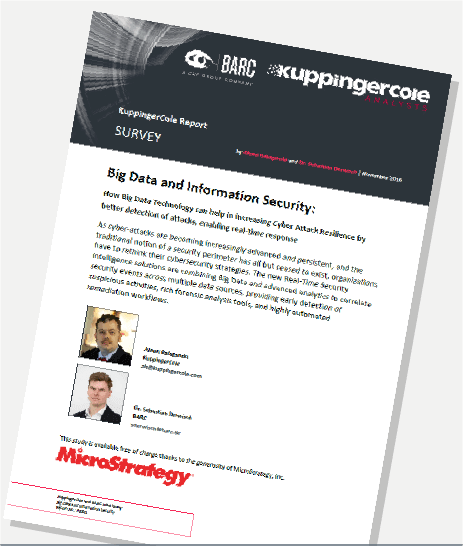The ongoing digitalization of the business world is putting companies at risk of cyber attacks more than ever before. Big data analysis has the potential to offer protection against these attacks. KuppingerCole and BARC’s “Big Data and Information Security” study looks in depth at current deployment levels and the benefits of big data security analytics solutions, as well as the challenges they face.
Cyber Security Threats are Rising
Since the notion of a corporate security perimeter has all but disappeared in recent years thanks to the growing adoption of cloud and mobile services, information security has experienced a profound paradigm shift from traditional perimeter protection tools towards monitoring and detecting malicious activities within corporate networks.
Increasingly sophisticated attack methods used by cyber criminals and the growing role of malicious insiders in several recent large scale security breaches clearly indicate that traditional approaches to information security can no longer keep up.
Companies Have to Rethink their Cyber Security Concepts
Analytics is the key element in leveraging cyber resilience. With increasingly advanced and persistent attacks and the simple fact that every organization must protect itself against all varieties of attacks while an attacker only needs one successful attempt, organizations must rethink their cyber security concepts. They have to move beyond pure prevention towards the PDR paradigm: Prevent – Detect – Respond.
How Big Data Analytics Fits In
At the core of this approach stands improved detection – and that is where big data analytics comes into play. Detection must be able to identify changing use patterns; to execute complex analysis rapidly, close to real time; to perform complex correlations across a variety of data sources ranging from server and application logs to network events and user activities.
This requires both advanced analytics beyond simple rule-based approaches and the ability to run analysis on large amounts of current and historical data – big data security analytics. Combining the current state of analytics with security helps organizations improve their cyber resilience.
Big Data Security Analytics: a New Generation of Security Tools
As the security industry’s response to these challenges, a new generation of security analytics solutions has emerged in recent years, which are able to collect, store and analyze huge amounts of security data across the whole enterprise in real time.
Enhanced by additional context data and external threat intelligence, this data is then analyzed using various correlation algorithms to detect anomalies and thus identify possible malicious activities.
Unlike traditional SIEM solutions, such tools operate in near real time and generate a small number of security alerts ranked by severity according to a risk model. These alerts are enriched with additional forensic details and are able to greatly simplify a security analyst’s job and enable quick detection and mitigation of cyber attacks.
What Made Big Data Security Analytics Possible
The biggest technological breakthrough that made these solutions possible is big data analytics.
The industry has finally reached the point where business intelligence algorithms for large-scale data processing, previously affordable only to large corporations, have become commoditized. Utilizing readily available frameworks such as Apache Hadoop and inexpensive hardware, vendors are now able to build big data solutions for collecting, storing and analyzing huge amounts of unstructured data in real time.
Combining Data to Predict Suspicious Activity
This makes it possible to combine real-time and historical analysis and identify new incidents that could be related to others that occurred in the past.
Coupled with external security intelligence sources that provide current information about the latest vulnerabilities, this can greatly facilitate identification of ongoing advanced cyber attacks on the network.
Having a large amount of historical data at hand also significantly simplifies initial calibration to the normal patterns of activity of a given network, which are then used to identify anomalies. Existing solutions are already capable of automated calibration with very little input required from administrators.
Identifying Relevant Incidents
Based on proven big data analytics algorithms, these solutions can identify outliers and other anomalies in security data, which almost always indicate some kind of malicious, or at least suspicious activity.
By filtering out the statistical noise, big data security analytics can reduce massive flows of raw security events to a manageable number of concise and clearly categorized alerts to allow even an inexperienced person to make a decision on them. Still, by keeping all historical information available for later analysis, it provides a forensic expert with much more detail about the incident and its relationship to other historical anomalies.
Automating Workflows
Finally, modern big data security analytics solutions provide multiple automated workflows for responding to detected threats, such as disrupting clearly identified malware attacks or submitting a suspicious event to a managed security service for further analysis. Automated controls for cyber security and fraud detection have been identified as one of the key business drivers for future adoption in this study.
Key Findings From The Big Data Security Analytics Report
The study delivers insights into the level of awareness and current approaches in information security and fraud detection in organizations around the world.
It measures the importance, current state and future plans of big data security analytics initiatives across different sectors, as well as presenting an overview of the various opportunities, benefits and challenges relating to those initiatives. It also outlines the range of technologies currently available to address those challenges.
Infographic video of the key findings
Static infographic of the key findings
Big Data and Information Security Report
How big data technology can help to increase cyber attack resilience by better detection of attacks, enabling real-time response.
Request the free report now






